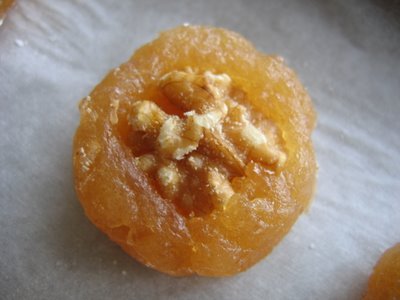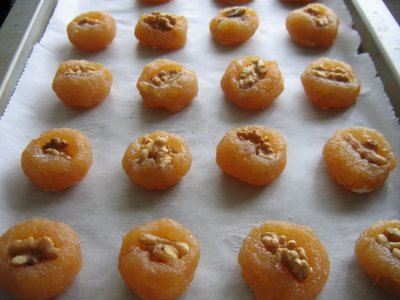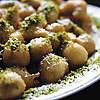dulces de membrillo
Solon of ancient times is said to have decided that Cydonian apples should be presented to newlyweds. Since they are pleasant to the taste and the digestion, their delicious charm stays in the mouth, so that the breath is made sweet by them.
from alciato's book of emblems
Coines, Coing, Cydonian apple, Pineapple quince, Quince, Quitte
derived from the portuguese word for it, called 'marmela'?
i used to think my parents came to canada smuggling quince fruit deep in their suitcases. that's how much i remember seeing this odd, inedible raw fruit [obviously, looking back as an adult it was around only during its season but it did figure a lot in our diet]. i say odd because i was intrigued as a child that it tasted like absolutely nothing, was hard as a rock but smelled of perfume and seemed almost exotic.
well, it tasted like nothing until it was cooked.
related to both the apple and pear, quince is a common mediterranean and european fruit. it has a very rich history and a quite fascinating one. historic foods.com has an exceptional article all about it with beautiful pictures of the delicacies and elaborate designs confectioners would make with the paste. do check it out. it is one of my favourite sites when it comes to food history and information. the splendid table has a short radiocast about the quince you can listen to telling you all about the fruit giving you a bit of its history, how to buy one and how it's prepared.
the quince starts off as a beautiful pink flower growing on gnarled trees. both my parents had quince trees in their yards and remember when they came to bloom. my mother told me ladies would stop to look at the flowers much like one is struck when seeing a magnolia tree in full bloom. [i never thought the quince blooms were anywhere as dramatic though and could compare].
when mature and harvested, it is usually medium sized to as big as a fist and naturally covered in a downy coating however more during its immature state. this is washed/cleaned off when it comes to market and home. the ones i bought still had tell-tale signs of this coating. i tried to show it in the crevices of the photo below.
 i grew up with knowing this called a few different ways — ayva, coing and membrillo/bimbriyo. none of my childhood friends at the time really knew what in the world this was if i mentioned it. it was foreign to them. quince has historically been a significant fruit in sephardic circles. in spanish it is called membrillo and is commonly jellied and served with manchego cheese in spain. in the ladino language it is called bimbriyo [the m is pronounced as a b], and is cooked the same way, used in jellies, jams and sweets. it is sometimes used in stews with meats and used as one of the fruits blessed at rosh hashana.
i grew up with knowing this called a few different ways — ayva, coing and membrillo/bimbriyo. none of my childhood friends at the time really knew what in the world this was if i mentioned it. it was foreign to them. quince has historically been a significant fruit in sephardic circles. in spanish it is called membrillo and is commonly jellied and served with manchego cheese in spain. in the ladino language it is called bimbriyo [the m is pronounced as a b], and is cooked the same way, used in jellies, jams and sweets. it is sometimes used in stews with meats and used as one of the fruits blessed at rosh hashana.the quince is high in pectin so it gels very easily. this is why it was a favourite for making jellied sweets and various jams and marmelades. as noted earlier, it was the original marmelade. in this post, i am showing you a very, very old [sephardic] sweet called dulses de bimbriyo or in castillian spanish, dulces de membrillo. these are usually made at passover and the new year. this confection is actually in a class of its own called, of course, dulses. they can be made from different fruit and sometimes vegetables, like squash. here is a link for some recipes similar to this one.
it takes a little time to prepare this confection as it must sit over night and then later the sweets need to cure for a few days to firm up properly and form a skin — otherwise they are just sticky and not easily handled. the preparation is quite straightforward and simple. nothing complicated, at all.
dulses de bimbriyo (dulces de membrillo)
makes approx. 20 to 24 sweets

ingredients:
2 quite large quince
white sugar [equals amount of mashed quince]
lemon juice, from half a small lemon
whole walnut halves or blanched almonds
icing sugar
bowl of water or a few tablespoons orange flower water
method:
peel the quince, cut in half and core them. cut the fruit into equal sized chunks.


 mash the fruit very well. you don't want chunks. alternatively, you may pass them through a food mill. do not use a blender or food processor.
mash the fruit very well. you don't want chunks. alternatively, you may pass them through a food mill. do not use a blender or food processor. measure out the quince purée and place in a medium sized bowl. remember how much it was and measure out the same amount of white sugar.
measure out the quince purée and place in a medium sized bowl. remember how much it was and measure out the same amount of white sugar. the next day you will notice that it has thickened and gelled up somewhat. place this back in a pan which is wide. add the juice of half a lemon. sometimes we added 1/8 - 1/4 tsp of cinammon.
the next day you will notice that it has thickened and gelled up somewhat. place this back in a pan which is wide. add the juice of half a lemon. sometimes we added 1/8 - 1/4 tsp of cinammon. over medium heat, cook the quince sugar mixture, stirring all the time with a spatula. the idea is to cook it down to reduce the moisture content and to bind the sugar with the fruit. the pectin in the quince with help it hold together further.
over medium heat, cook the quince sugar mixture, stirring all the time with a spatula. the idea is to cook it down to reduce the moisture content and to bind the sugar with the fruit. the pectin in the quince with help it hold together further. do not leave during the cooking process. it can burn and be ruined. keep stirring the mixture and turn it on top of itself. a good sign is that it will start to clear away from the sides of the pan. keep cooking it. eventually it will become more solid and putty like. it takes about 30 to 40 minutes in total, depending on your heat. do not cook it so much as to dry it out.
do not leave during the cooking process. it can burn and be ruined. keep stirring the mixture and turn it on top of itself. a good sign is that it will start to clear away from the sides of the pan. keep cooking it. eventually it will become more solid and putty like. it takes about 30 to 40 minutes in total, depending on your heat. do not cook it so much as to dry it out. take this off the heat source and let it rest covered for about 10- 15 minutes. it should be warm and not hot. mash it with a potato masher. you don't want any lumps in it. do it for about a minute or so.
take this off the heat source and let it rest covered for about 10- 15 minutes. it should be warm and not hot. mash it with a potato masher. you don't want any lumps in it. do it for about a minute or so.this is a picture of how it will look. do not let it cool too much or you will have problems with the following steps. if it does become too cool to work, reheat it a bit and mash it again.
 take a spoon and make small one and a half inch [approximately] balls. when you roll the balls, you will need to have hands moistened with water, not dripping wet. put a bowl of water next to you when you work or you can you can also use a bit of orange flower water. put a 1/2 teaspoon in your palm and "wash your hands" by rubbing them together and repeat as needed. place these balls on a piece of parchement or foil on a cookie sheet. parchment is better. you should get from 20 - 24 approximately depending on how much quince paste you used. i started with 1 1/2 c of mashed quince.
take a spoon and make small one and a half inch [approximately] balls. when you roll the balls, you will need to have hands moistened with water, not dripping wet. put a bowl of water next to you when you work or you can you can also use a bit of orange flower water. put a 1/2 teaspoon in your palm and "wash your hands" by rubbing them together and repeat as needed. place these balls on a piece of parchement or foil on a cookie sheet. parchment is better. you should get from 20 - 24 approximately depending on how much quince paste you used. i started with 1 1/2 c of mashed quince. take a walnut and place it in the center. push it in and flatten it slightly. it should be approximately an inch thick.
take a walnut and place it in the center. push it in and flatten it slightly. it should be approximately an inch thick.
 now let the dulses cure for 24 hours on one side. turn them over the next day and let the other side dry. this is all done uncovered. make sure it's in a dry place.
now let the dulses cure for 24 hours on one side. turn them over the next day and let the other side dry. this is all done uncovered. make sure it's in a dry place. after they have cured, put icing sugar in a medium bowl or ziploc. place one or two candies in the sugar and roll to cover completely. these can be stored in a tin for a very long time. they actually taste better with age.
after they have cured, put icing sugar in a medium bowl or ziploc. place one or two candies in the sugar and roll to cover completely. these can be stored in a tin for a very long time. they actually taste better with age.






































